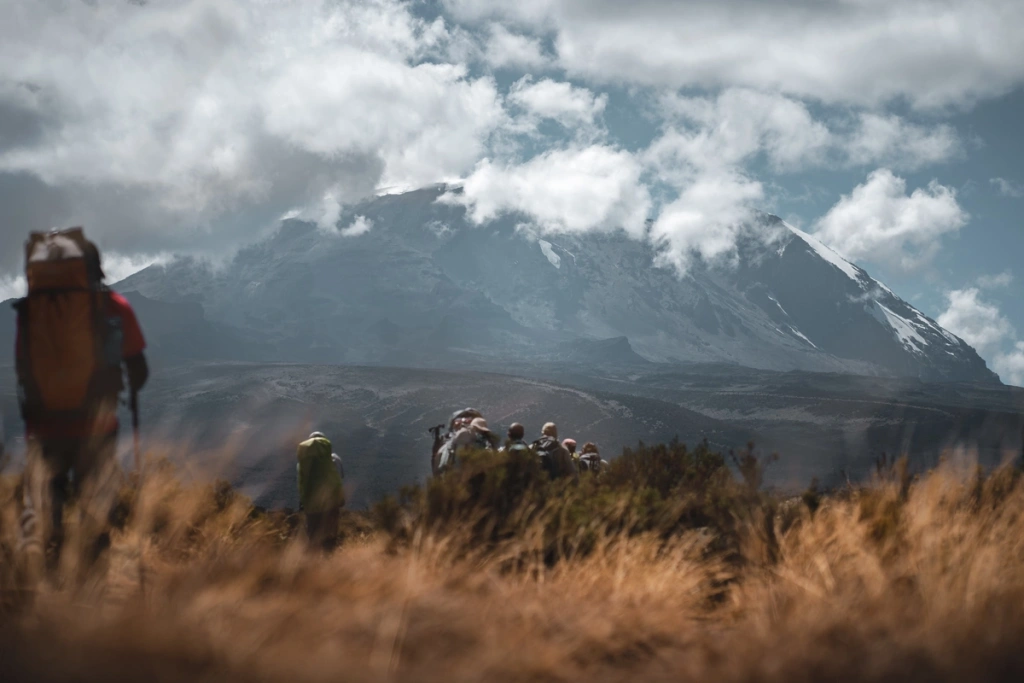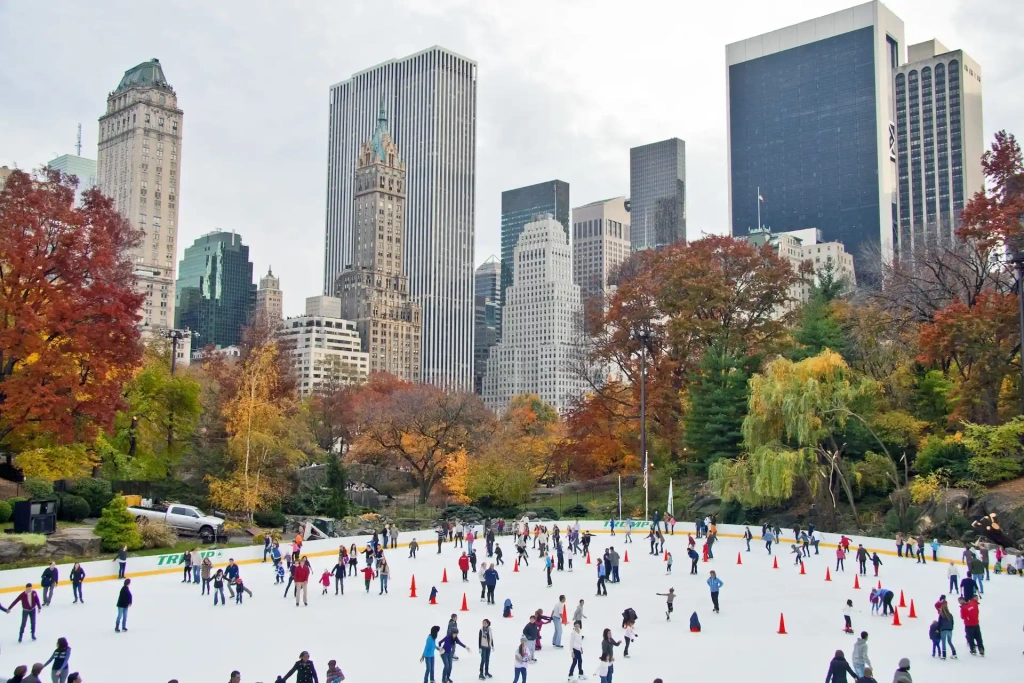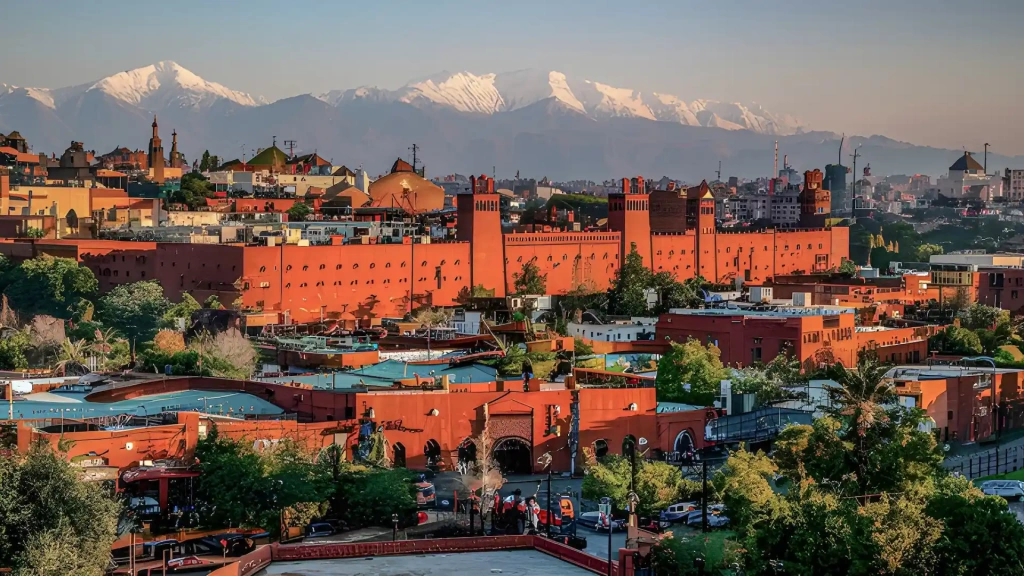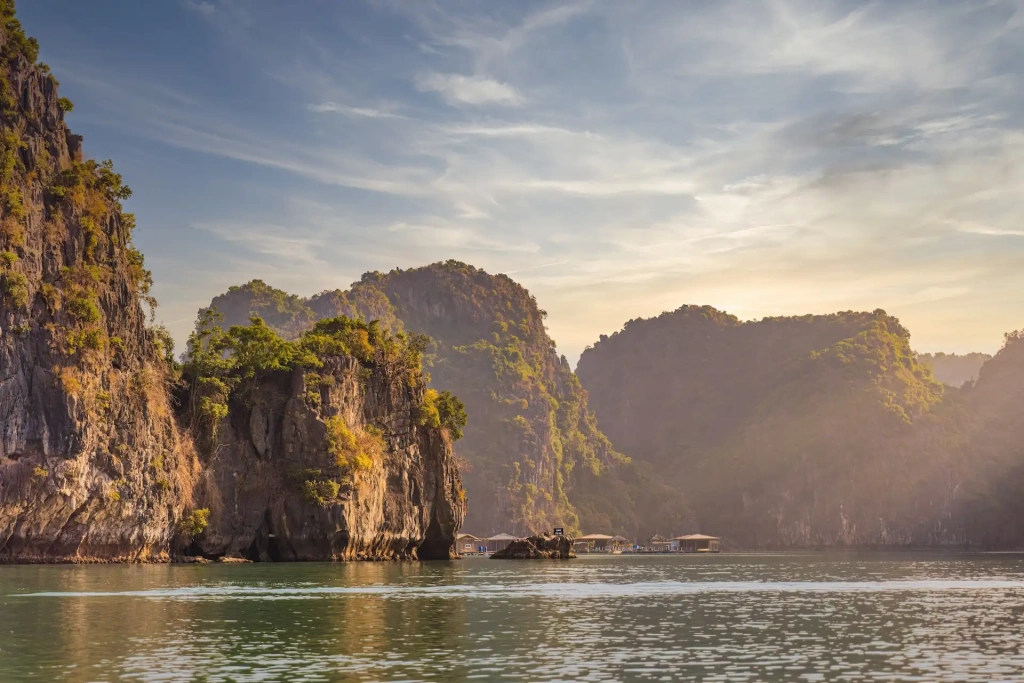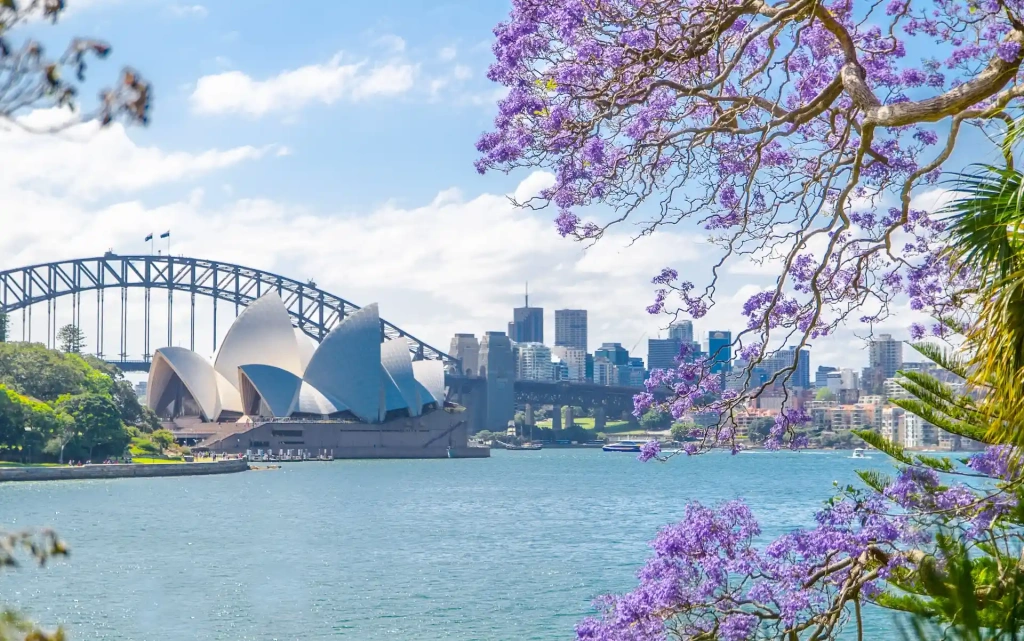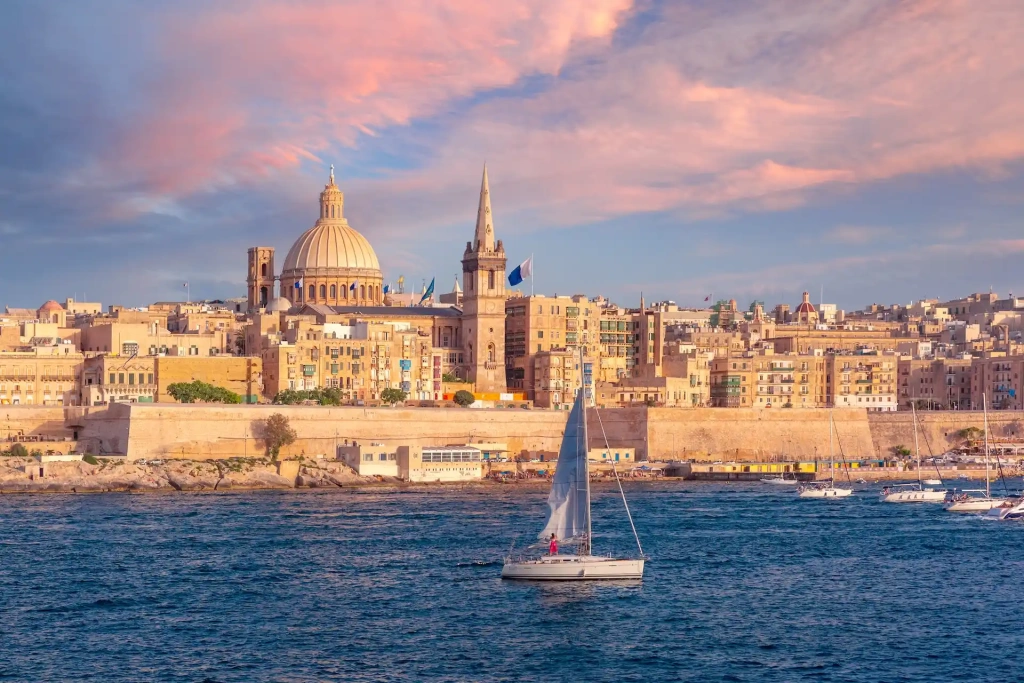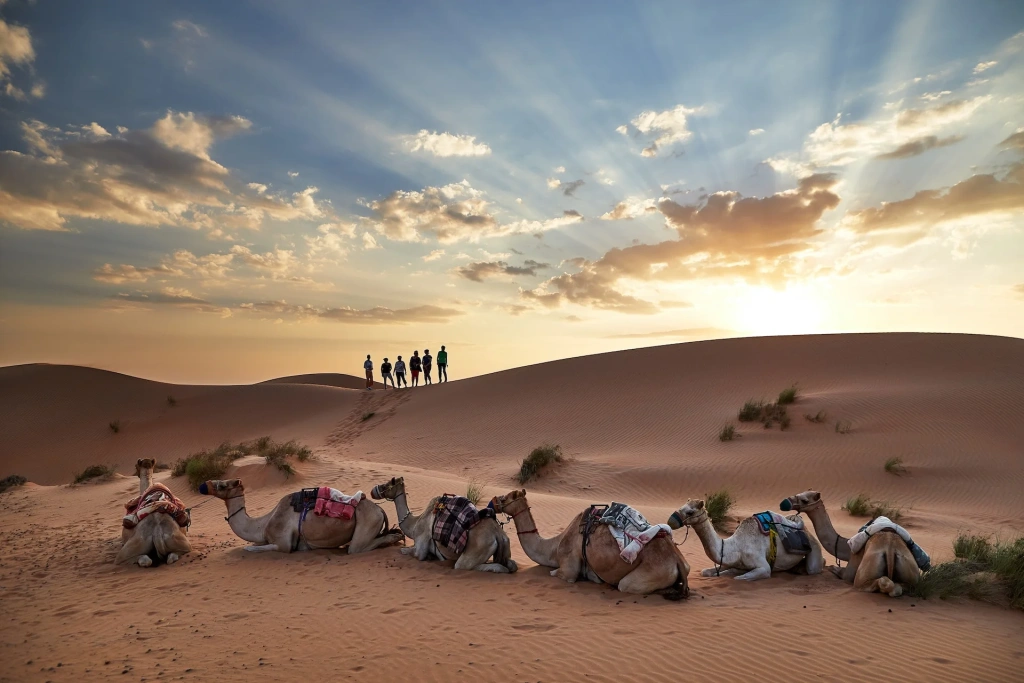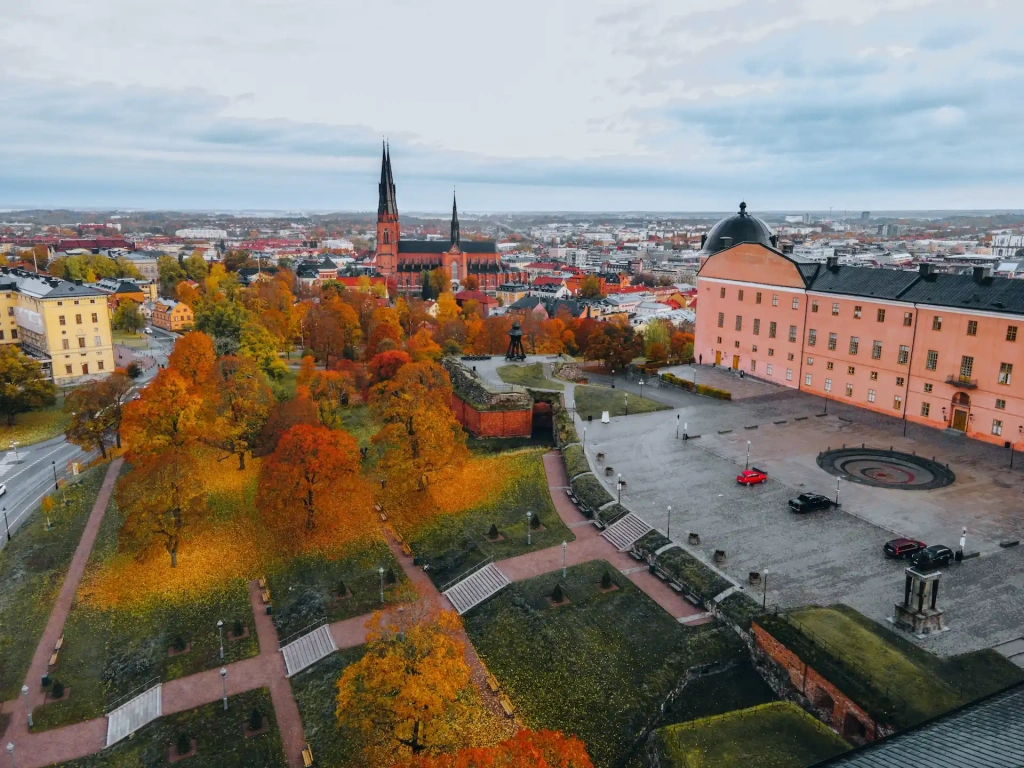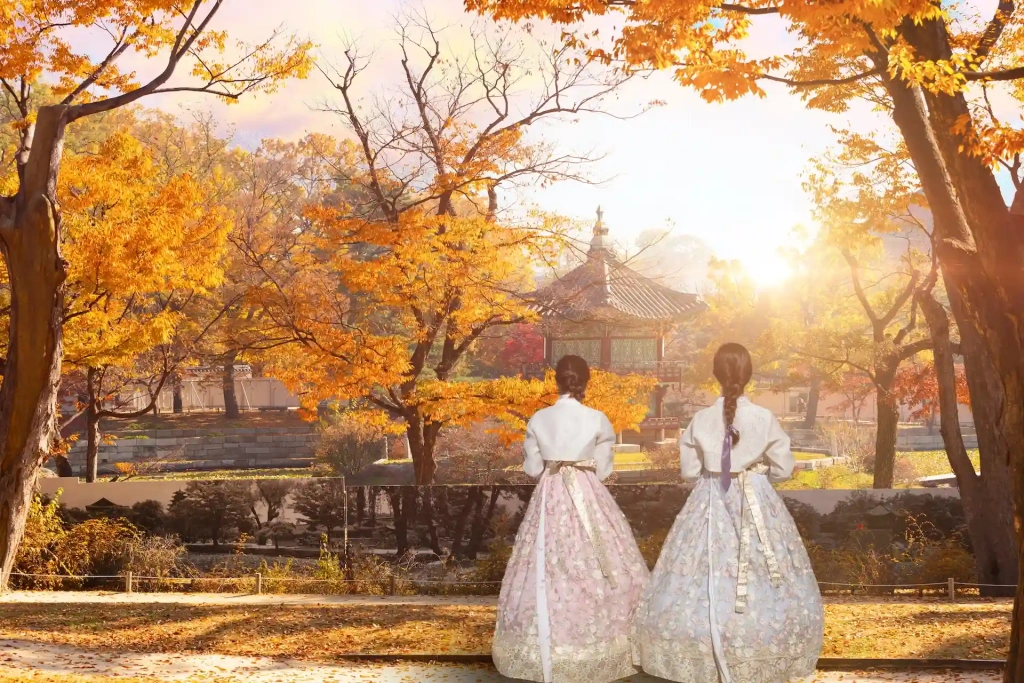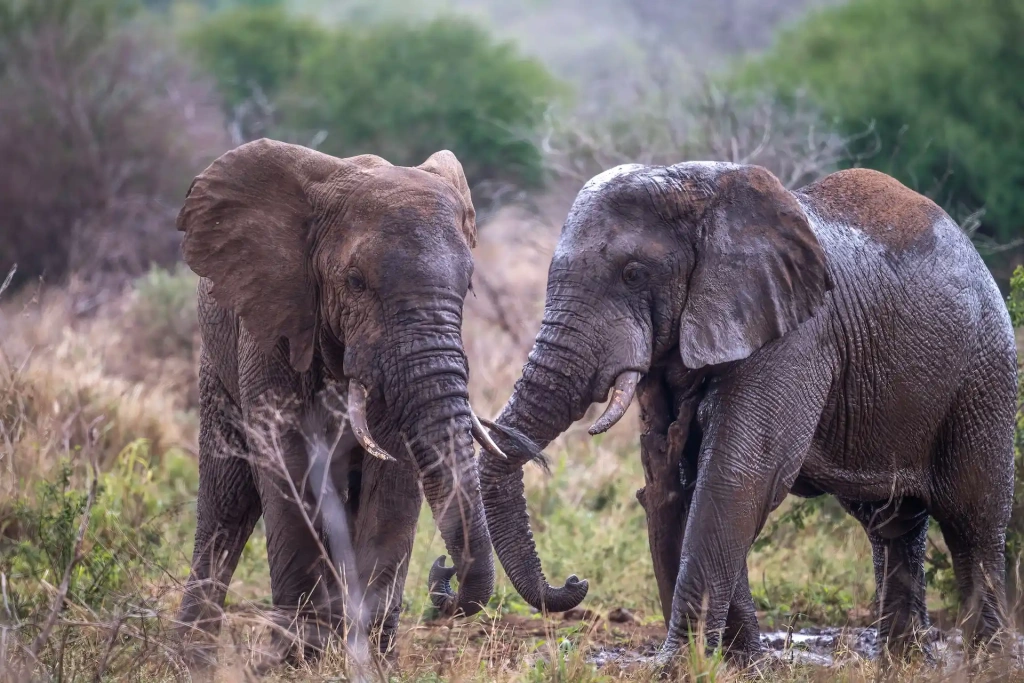In the off-season, mild weather offers the chance to lounge by the sea in southern Vietnam and Oman, observe wildlife in Tanzania and admire autumn colours in South Korea. Urban explorers will find their fix in the USA and Argentina, while those after winter fun should head to Sweden, where doctors can now prescribe travel for health reasons.
The Altezza Travel team has compiled 11 destinations around the world where November offers something special — from quiet beaches and cultural escapes to safaris and mountain climbs.
Where to travel in November?
(52–81 °F / 32–70 °F)
(72–75 °F / 46–54 °F)
(68–82 °F / 61–75 °F)
(75–79 °F / 59–63 °F)
(46–77 °F / 41–70 °F)
(61–72 °F / 68–88 °F)
(64–70 °F / 55–59 °F)
(79–88 °F / 68–73 °F)
(28–41 °F / down to 5 °F)
(46–54 °F / 32–37 °F)
United States: from Arizona’s canyons to New York’s ice rinks
- Climate in November: It depends on the state. In New York, daytime temperatures average +11–12 °C (52–54 °F), dropping to 0–4 °C (32–39 °F) at night. In southern cities like Miami, it’s much warmer — +25–27 °C (77–81 °F) during the day and +18–21 °C (64–70 °F) at night.
- What to see: Thanksgiving and Christmas markets in New York, the Grand Canyon in Arizona, surfing in Hawaii.
The United States is one of the best destinations for a November vacation. By this time, the high season has ended, airfares and hotel prices drop noticeably, and in many states, the weather remains pleasant enough for long walks and outdoor adventures. The only major exception is the last Thursday of the month, when Thanksgiving is celebrated. Due to massive sales and public festivities, expect crowds in shopping malls, on city streets, and around popular attractions.
That said, this holiday brings unique experiences too. In New York, you can witness the world-famous Macy’s Thanksgiving Day Parade, featuring giant inflatable balloons, live music, and performers — one of the most famous annual events in the United States.
Later in the month, New York transforms into a winter wonderland with its festive markets: Union Square Holiday Market and Bryant Park Winter Village, the latter located beside an ice rink surrounded by skyscrapers. Another rink opens early at Rockefeller Center, before the official lighting of the Christmas tree — a great chance to skate with fewer crowds.
New York’s cultural scene is equally rich in November. Take time to visit the Metropolitan Museum of Art and MoMA, both home to world-renowned collections of classical and contemporary art.
In the southwest, the weather becomes ideal for hiking. The Grand Canyon, Arizona’s most famous landmark, remains open for visitors but is far less crowded than in summer. The Bright Angel Trail is the park’s most popular and scenic route descending into the canyon. Keep in mind that the climb back up takes roughly twice as long as the descent — something the U.S. National Park Service always advises to plan carefully.
In Hawaii, November marks the start of the surfing season. On the islands of Oʻahu and Maui, the Triple Crown of Surfing begins — a series of international competitions drawing professional surfers and large audiences from around the world. Beyond sports, there’s plenty to enjoy: the ocean remains warm at +26–27 °C ( 79–81 °F), perfect for swimming, snorkeling, or simply relaxing by the beach.
Morocco: centuries of history and the silence of the Sahara
- Climate in November: Around +22–24 °C (72–75 °F) during the day and +8–12 °C (46–54 °F) at night. In the mountains and desert, it can be cooler and occasionally rainy.
- What to see: Ancient monuments in Marrakech and Fes, the sand dunes of Erg Chebbi, and the Atlas Mountains.
Late autumn in Morocco offers a rare combination of warm weather and a calm tourist season. With average daytime temperatures around +23 °C (73 °F) and no sweltering heat, you can comfortably explore cities and landscapes throughout the day.
In the country’s east, November is the perfect time to visit the golden-red dunes of Erg Chebbi near the village of Merzouga. Spending a night in a Berber desert camp is an unforgettable experience — you can reach it by camel or a 4×4 vehicle.
Those who prefer active travel can head to the Atlas Mountains, where hiking routes include the ascent of Mount Toubkal — at 4,167 m (13,671 ft), it is the highest peak in North Africa, located just 60 km (37 mi) from Marrakech.
Set aside at least two days to explore Marrakech itself. Visit Jemaa el-Fna Square, where water sellers, dancers, musicians, and snake charmers fill the air with sounds and colors. Don’t miss the Koutoubia Mosque, whose 70-meter (230-ft) minaret dominates the skyline. UNESCO recognizes Marrakech as “a completed example of a major Islamic capital of the western Mediterranean.”
For a coastal experience, travel to Essaouira, a port city that has seen Romans, traders, and even medieval pirates. Another must-see is Fes, Morocco’s spiritual and cultural heart. Here you’ll find the medieval Bou Inania and Al-Attarine , as well as the University of Al-Karaouine, founded in 859 AD and listed in the Guinness World Records as the world’s oldest continually operating university.
All in all, Morocco is one of the best places to go in November.
Vietnam: beaches and calm skies at the edge of the monsoon
- Climate in November: In the north (Hanoi / Ha Long), daytime ≈ +20–24 °C (68–75 °F), night ≈ +16–18 °C (61–64 °F). In the south, daytime ≈ +28 °C (82 °F), night ≈ +24 °C (75 °F).
- What to see: Ha Long Bay and its surroundings, Hanoi’s colonial Old Quarter, and beaches on Phu Quoc Island.
Vietnam is a year-round destination — you just need to choose the right region for the season. November is ideal for a relaxed getaway before the busy high season begins in December, when resort prices rise and crowds grow.
For a beach holiday, head south. By November, the heavy rains in Nha Trang and Phan Thiet have ended, and both air and sea temperatures stay around +28 °C (≈ 82 °F). On Phu Quoc Island, small, shallow beaches are perfect for families, while divers can explore coral reefs teeming with moray eels, rays, and sea turtles. Hikers will enjoy tropical forests and scenic lakes, including Duong Dong and Phu Quoc National Park. The coastal town of Vung Tau is popular with surfers — the sea is calm, and surf schools and rental shops are easy to find.
In northern Vietnam, the stunning Ha Long Bay becomes especially atmospheric in winter. Early morning mists shroud the limestone cliffs, creating a dreamlike scene. Cruise boats glide between the islands, with longer itineraries offering visits to nearby islets and caves.
Vietnam’s capital, Hanoi, is an attraction in itself — a fascinating blend of eras and influences. You’ll find statues of Lenin and the mausoleum of national leader Ho Chi Minh, the Opera House modeled after Paris’s Grand Opéra, and the Old Quarter with its narrow lanes and ancient Buddhist pagodas — all within a few kilometres of each other.
Rwanda: the green heart of East Africa
- Climate in November: The short rainy season brings brief showers. Daytime temperatures average +24–26 °C (75–79 °F), and nights stay mild at +15–17 °C (59–63 °F).
- What to see: Primates and birds in national parks, and resorts around Lake Kivu.
Rwanda is a small yet beautiful country in East Africa. In November, the rains arrive, refreshing the air and making the scenery greener and more vibrant. In the capital, Kigali, daytime temperatures hover around 25–26 °C (≈ 77–79 °F).
In the forested regions, trails can become slippery due to the rain, but this season is ideal for birdwatching and primate trekking. In Nyungwe National Park in the southwest, November marks the start of bird migration. The park is also home to over 500 chimpanzees, which tend to move closer to trekking paths as they forage for food during the rainy months.
Many travelers come to Rwanda to see mountain gorillas in the wild. According to Visit Rwanda, Volcanoes National Park is home to 12 habituated gorilla groups. To protect these endangered animals, the government limits visitor numbers and requires a special permit for gorilla trekking.
Just an hour’s drive from the park lies Lake Kivu, a stunning body of water on the border with the Democratic Republic of the Congo. Its northern town, Rubavu, features elegant colonial-era mansions and trendy lakeside bars, while on the eastern shore, the Karongi resort area is surrounded by pine- and eucalyptus-covered hills — an ideal place to unwind after a safari.
Argentina: springtime cities, tango, and football
- Climate in November: In Buenos Aires, daytime ≈ +20–25 °C (68–77 °F), nighttime ≈ +12–16 °C (54–61 °F). In the south, it’s cooler and windy — daytime ≈ +8–15 °C (46–59 °F), nighttime down to ≈ +5 °C (41 °F).
- What to see: Buenos Aires, Iguazu Falls (at their fullest flow), and Patagonia’s fjords and landscapes.
Argentina lies south of the equator, so its seasons are the opposite of Europe’s. November marks the end of spring, when nature bursts into bloom, the days grow longer, and the weather stays pleasantly warm without the stifling heat of summer. When the question “where to go in November” comes up, Argentina is always a great choice.
Start your trip in Buenos Aires, where temperatures average between 20 and 30 °C (≈ 68–86 °F) — perfect for strolling through the city’s elegant avenues and jacaranda-lined parks. The atmosphere is lively yet relaxed, with open-air cafés, tango music, and blooming plazas everywhere you go.
To truly immerse yourself in Argentine culture, take a tango class — the national dance is taught in studios across the city. Lonely Planet recommends La Viruta and Villa Malcolm, both open daily and popular among locals.
Football is another passion that defines Argentina. If you can, attend a Boca Juniors match in Buenos Aires — one of Latin America’s most legendary clubs and the former team of 1986 World Cup champion Diego Maradona.
Outside the capital, Argentina’s diverse geography offers endless adventure. November is a great time to explore Patagonia, where snow-capped mountains, crystal-clear lakes, and alpine meadows stretch to the horizon. Further north, the Iguazu Falls, a UNESCO World Heritage Site, thunder down from basalt cliffs nearly 80 meters (262 ft) high. Made up of 275 separate cascades, they’re at their most powerful in November, after the rainy season — an awe-inspiring sight of nature’s might.
Australia: city views, warm ocean, and late spring
- Climate in November: In Sydney and the southern regions, daytime ≈ +20–22 °C (68–72 °F), night ≈ +16 °C (61 °F). In the north (Cairns), daytime ≈ +28–31 °C (82–88 °F), night ≈ +22–24 °C (72–75 °F).
- What to see: Sydney Harbour and Opera House, kangaroo sanctuaries, Aboriginal art, the Outback, and the Great Barrier Reef.
Like Argentina, Australia enters the final month of spring in November. The weather is mild across most of the country, though evenings can be cool — a light sweater is useful for late walks along the coast.
Most international visitors begin their journey in Sydney, one of Australia’s largest and most iconic cities. Start at Sydney Harbour, where two landmarks stand side by side: the Sydney Opera House and the Harbour Bridge. You can even climb the bridge with a licensed guide to take in panoramic views of the city skyline and the Pacific Ocean.
Sydney’s coastline is another treasure. The city boasts over 100 beaches, ranging from bustling spots like Bondi Beach — popular for swimming, surfing, and snorkeling — to quieter hideaways perfect for families, such as Manly, Balmoral Beach, and Watsons Bay.
Further north, in Queensland, lies the Great Barrier Reef — the largest coral reef system on Earth. It’s inscribed on the UNESCO World Heritage List and visible even from space. From the coastal city of Cairns, you can take boat tours to dive or snorkel among giant clams weighing up to 200 kg (≈ 440 lb), sea turtles, colorful clownfish, and reef sharks. With luck, you may even spot humpback whales, which give birth in these waters during this season.
For a true sense of Australia’s wild spirit, venture inland to the Outback — the vast, sparsely populated desert regions that cover about 80% of the continent. The classic Outback route begins at Uluru (Ayers Rock), a massive sandstone formation rising dramatically from the red earth, about 340 km (211 mi) from Alice Springs.
The Outback is sacred to Australia’s Aboriginal peoples, who have lived on this land for more than 40,000 years. In New South Wales and the Northern Territory, you can see ancient rock art and learn about Indigenous traditions that have survived into the modern day.
Malta: late autumn and the legacy of the knights
- Climate in November: Daytime ≈ +18–21 °C (64–70 °F), night ≈ +13–15 °C (55–59 °F). Rain is more frequent but usually short-lived, quickly giving way to sunshine.
- What to see: The historic center of Valletta, megalithic temples, and medieval fortresses of the Knights of Malta.
Malta is a small island nation steeped in history. Ancient temples such as Ħaġar Qim and Mnajdra, older even than the Egyptian pyramids, stand alongside the medieval walled city of Mdina, known for its narrow lanes and thick limestone walls.
November’s mild weather makes it an excellent time for walking tours. Begin your exploration of Valletta, the UNESCO-listed capital, at the Upper Barrakka Gardens for sweeping views over the Grand Harbour. Continue to the Grand Master’s Palace of the Knights of Malta, the city’s central square with its ornate fountains, and the modern Parliament building nearby.
Expect more rainfall than in the summer season. When it passes through, you can take shelter in the National Museum of Archaeology or the St. John’s Co-Cathedral and admire two masterpieces by Italian painter Caravaggio. The city’s fortifications are also worth exploring: Fort St. Elmo, home to the National War Museum, and Fort Ricasoli, a filming location for Hollywood epics like Troy and Gladiator.
Late autumn is also Malta’s cultural season. Early November brings classical concerts, art exhibitions, and installations in historic palaces and cathedrals — many inspired by ancient or Renaissance themes. In the first half of the month, Valletta hosts the Malta Book Festival, the country’s largest literary event.
Oman: modern mosques, desert dunes, and “the Arabian Norway”
- Climate in November: In Muscat, daytime ≈ +26–31 °C (79–88 °F), nighttime ≈ +20–23 °C (68–73 °F). The weather is dry and comfortable compared to summer.
- What to see: Modern Islamic architecture in Muscat, the Wahiba Sands Desert, and the fjords of the Musandam Peninsula.
For warm seas and rich Middle Eastern flavor, November is one of the best times to visit Oman. The air is dry, the heat of summer has faded, and daytime temperatures rarely exceed +30 °C (86 °F).
Start your journey in Muscat, the capital and largest city. One of its main landmarks is the Sultan Qaboos Grand Mosque, opened in 2001. Its design blends traditional Islamic aesthetics with understated opulence. The main prayer hall, which accommodates up to 6,500 worshippers, is covered by a massive 70 × 60 m (230 × 197 ft) Persian carpet — woven by more than 600 Iranian craftswomen over four years. Above it hangs a magnificent 14-meter (46-ft) chandelier adorned with Swarovski crystals and weighing about eight tons.
For an evening of music, visit the Royal Opera House Muscat, which has hosted world-class performers including Plácido Domingo, Andrea Bocelli, the Mariinsky Ballet, and the London Philharmonic Orchestra.
A stroll through Muttrah Souq, one of the oldest markets in the Arab world, is another essential Muscat experience. Located near the port, the bazaar offers a mix of traditional fragrances, silver jewelry, textiles, and local crafts.
Beyond the city, the country’s dramatic landscapes beckon. The Wahiba Sands (Ramlat al-Wahiba) are an ocean of sand dunes that you can explore by 4×4 vehicle or during a night of camping in a Bedouin camp. In Oman’s far north lies the Musandam Peninsula, nicknamed “the Arabian Norway” for its rugged fjords and turquoise bays. In the coastal town of Khasab, visitors can explore a 17th-century Portuguese fort, cruise on traditional dhow boats, or go diving among vibrant coral reefs.
Sweden: holiday spirit, first snow, and northern lights
- Climate in November: In Stockholm, daytime temperatures reach +1–5 °C (34–41 °F) and hover around 0 °C (32 °F) at night. In the north, it’s already full winter — from −2 °C to +2 °C (28–36 °F) during the day and down to −15 °C (5 °F) at night.
- What to see: Cultural landmarks and Christmas markets in Stockholm, traditional crafts in Dalarna, and ski resorts in northern Sweden.
November brings the chill to Sweden. In Stockholm, temperatures stay near +5 °C (41 °F); in Malmö, it’s slightly warmer, while the country’s north is already covered in snow. Days are short, skies are often grey, yet Sweden’s cozy atmosphere and festive anticipation make it a magical time to visit.
From November 5–16, the Stockholm International Film Festival takes place, while museums and art spaces launch their winter programs. By late November, Christmas markets open across the capital — the most famous ones in Gamla Stan (the Old Town) and at Taxinge Castle, filling the air with mulled wine and gingerbread aromas.
A short trip north of Stockholm leads to Uppsala, one of Sweden’s oldest cities. Highlights include Uppsala University, founded in 1477, and the Uppsala Cathedral, a Gothic masterpiece where Swedish kings were crowned.
To experience Swedish folk traditions, head to Dalarna Province, where artisans craft the famous Dala horses (dalahäst) — brightly painted wooden figures that have become national symbols on par with IKEA furniture.
Further north, winter arrives in full force and the ski season begins. The Sälenfjällen ski area in Dalarna, stretching over 30 km (≈ 19 mi), is Scandinavia’s largest, with gentle slopes ideal for beginners and intermediate skiers. In Lapland, the season brings a different kind of wonder — the dazzling Northern Lights illuminating snowy forests under long polar nights.
South Korea: autumn colors, ancient heritage, and fresh seafood
- Climate in November: In Seoul, daytime ≈ +8–12 °C (46–54 °F), nighttime 0 to +3 °C (32–37 °F). The weather is generally dry and clear, though light snow is possible by the end of the month.
- What to see: The Han River promenade, royal palaces and shopping districts in Seoul, Buddhist temples in the southeast, Busan, and Jeju Island.
South Korea is one of the most rewarding destinations to visit in November. The first half of the month still brings mild autumn weather, while the second half signals the approach of winter. This is also the clearest month of the year — rare rainfall makes it perfect for city walks and hikes in the country’s national parks.
In Seoul, visitors can still enjoy the last of the autumn foliage along the Han River, near Cheonggyecheon Stream in the city center, and at the Gyeongbokgung Palace, built in the 14th century. For panoramic views, take the cable car up Namsan Mountain, which overlooks the vast 10-million-strong metropolis.
November weather can change quickly, so layering is key — bring a warm scarf, gloves, and a hat. Fortunately, Seoul’s countless cafés and street-food stalls make it easy to stay warm. Korea’s coffee culture is thriving, and small restaurants serve hearty dishes right on the street, surrounded by steam and delicious aromas.
It’s also the perfect time for seafood lovers. As the sea cools, the flavor of freshly caught oysters, fish, and snow crab becomes richer and more delicate — and many coastal restaurants celebrate this with seasonal menus.
Though modern South Korea was founded in 1949, the Korean Peninsula’s history stretches back thousands of years. In Gyeongju, in the southeast, visitors can explore the Cheomseongdae Observatory (7th century AD), the Seokguram Grotto, and the nearby Bulguksa Temple. These sacred Buddhist sites are considered national treasures and are both listed as UNESCO World Heritage Sites.
Tanzania: safaris, whale sharks, and tourist-free Kilimanjaro
- Climate in November: Daytime ≈ +26–28 °C (79–82 °F), nighttime ≈ +14–17 °C (57–63 °F).
- What to see: Serengeti and Ngorongoro, the islands of Mafia and Pemba, and Mount Kilimanjaro.
In Tanzania, November marks the start of the short rainy season, which lasts until mid-December. Some roads in national parks become muddy, and wildlife disperses more widely than in the dry months — but this season also brings new beauty. The savannah turns lush and green, skies clear after showers, and animals are especially active, creating ideal conditions for wildlife photography. Fewer tourists visit during this period, and lodges often offer lower rates.
Tanzania is one of the few places in the world where you can see whale sharks, which can reach 18–20 meters (≈ 59–66 ft) in length. In November, they feed on plankton in the channel between Mafia Island and the mainland before migrating toward Australia in February and returning to Tanzanian waters in autumn.
This is also the time of the Great Migration, one of Earth’s most spectacular wildlife events — described by UNESCO as “one of the most impressive natural phenomena visible even from space.” From November to December, huge herds of wildebeest and zebras can be observed on safari in the central and southern Serengeti.

Another excellent safari destination is Tarangire National Park, located about 120 km (75 mi) from Arusha in northern Tanzania. With the rains returning, the Tarangire River valley comes alive — herds of elephants roam the plains alongside buffalo, giraffes, zebras, and hyenas.
In the country’s southwest lies the Selous Game Reserve, one of Africa’s finest bird-watching sites. During the rainy season, the Kilombero River floods the grassy plains, attracting thousands of waterbirds, including rare endemic species like the Kilombero weaver (Ploceus burnieri) and Kilombero cisticola (Cisticola bakerorum), found nowhere else on Earth.
Around Mount Kilimanjaro, the air becomes cooler in November, but climbing expeditions continue to run. While the slopes receive more rainfall, the routes are quieter and the scenery more vibrant — the mountain’s green forests and open moorlands are particularly stunning during this season.
Frequently Asked Questions
What are the best places to visit in November?
For beaches and warm seas, head to Oman, Vietnam, or Malta. For trekking and wildlife, consider Argentina’s Patagonia, Tanzania, or Rwanda. If you prefer city breaks, New York, Stockholm, and Seoul offer culture, events, and festive charm.
Where to go in November for swimming in the sea?
Sea temperatures are around +28 °C (82 °F) on Phu Quoc, +26–31 °C (79–88 °F) in Muscat, and +26–28 °C (79–82 °F) along Tanzania’s coast. In Malta, the water is about +20 °C (68 °F) — swimming is possible, though it depends on the day’s weather.
What should I pack for a November trip?
Dress in layers to adapt to changing conditions. In warm destinations like Morocco, Vietnam, Oman, Australia, and Argentina, bring lightweight natural fabrics, a hat, and sunscreen. In cooler regions such as the USA, South Korea, and Sweden, pack a warm jacket, sweater, scarf, and waterproof shoes. For Rwanda and Tanzania, where short rains occur, waterproof clothing and boots are essential.
All content on Altezza Travel is created with expert insights and thorough research, in line with our Editorial Policy.
Want to know more about Tanzania adventures?
Get in touch with our team! We've explored all the top destinations across Tanzania. Our Kilimanjaro-based adventure consultants are ready to share tips and help you plan your unforgettable journey.















